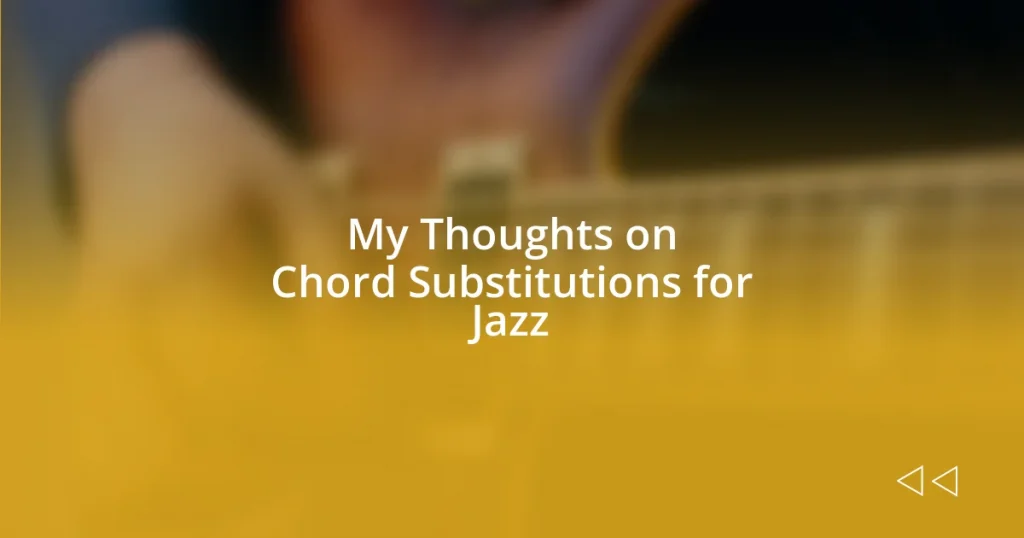Key takeaways:
- Chord substitutions, like tritone and chromatic substitutions, enhance the emotional texture and harmonic depth of jazz performances.
- Common chord progressions, such as ii-V-I and I-vi-ii-V, serve as fundamental frameworks that evoke different emotions and enrich musical storytelling.
- Experimentation with unconventional substitutions fosters creativity and collaboration among musicians, leading to fresh, unexpected musical experiences.

Understanding Chord Substitutions
Chord substitutions are an exciting aspect of jazz that really can elevate your playing. I remember the first time I discovered a simple substitution—I was jamming with friends and someone suggested using a b7 chord instead of the regular 7. It felt like suddenly opening a door to a whole new room of sounds! Isn’t it fascinating how a small change can completely transform the emotional landscape of a piece?
Understanding the theory behind chord substitutions is crucial, as they often involve altering a chord’s function. For example, the tritone substitution replaces a dominant chord with another that is a tritone away. This can create a richer harmonic texture and add unexpected tension to your progression. Have you ever noticed how certain chord changes evoke different feelings or colors? I always find it thrilling to explore these contrasts.
When I play with a group, experimenting with substitutions sparks a certain joy among musicians. It’s that magical moment when everyone is on the same page, and the music shifts into something special. I ask myself, what would happen if I tried a different substitution here? The answer often leads to new discoveries, making every performance an adventure. Chord substitutions invite both risk and creativity, don’t they?

Types of Chord Substitutions
When diving into the types of chord substitutions, one of the most common and versatile options is the tritone substitution. I remember a session where I tried substituting a G7 with a Db7 that was a tritone away. The change introduced an intriguing tension that surprised both me and my bandmates. It’s amazing how a simple shift can breathe new life into a standard progression.
Another popular substitution is the major and minor variations. For instance, substituting a major chord with its relative minor can create a beautifully contrasting sound. During a casual gathering once, I played Cmaj7 and switched it to A7, which lent the piece a fresh, somber vibe. This experience really highlighted how our emotional responses to music can be steered by these subtle changes.
Lastly, there are chromatic substitutions that incorporate chords a half step away from the original. These can produce a sense of urgency and movement within a progression. I once had a moment in a slow ballad where I layered a B7 in place of a C chord. It added a tantalizing twist that brought the whole piece together and resonated deeply with the audience. Each type of substitution offers a journey that can profoundly enhance your musical storytelling.
| Type of Substitution | Description |
|---|---|
| Tritone Substitution | Replaces a dominant chord with another chord a tritone away. |
| Major/Minor Variations | Substitutes a major chord with its relative minor for contrast. |
| Chromatic Substitution | Involves chords a half step apart to create movement and urgency. |

Common Patterns in Jazz Chords
When I reflect on common patterns in jazz chords, I can’t help but think about the cyclical nature of progressions. A classic example is the ii-V-I progression, which feels almost like a musical handshake—a friendly connection between chords that leads to resolution. I remember playing with a trio, and we hit that progression, creating a sense of anticipation before moving to the tonic. It’s almost like a journey that feels both familiar and exciting every time.
Here are some common chord patterns found in jazz:
- ii-V-I Progression: The most fundamental progression, where the ii chord leads to the V chord, resolving to the I.
- I-vi-ii-V: This pattern adds richness and depth, often used in standards.
- III-VI-II-V: A circular pattern that creates a smooth transition, perfect for building momentum.
- Backdoor Progression: Uses the bVII7 chord to approach the I chord, giving a softer resolution.
These patterns not only serve to structure a piece but also evoke different emotions that can grow and evolve throughout a performance. They remind me of painting with broad strokes and intricate details, weaving together to create a tapestry of sound that captivates both the performer and the audience.

Practical Applications of Substitutions
Employing chord substitutions can significantly enhance your practice and performance. For instance, I often experiment with adding a secondary dominant before the ii chord in a progression. This technique really shines when you’re moving toward the V chord, creating an exciting lead-in. I recall a jam session where I used a D7 in place of the standard A7 before moving to Bm, and the extra tension it built was palpable; it made listeners sit up and engage in ways I hadn’t expected.
In my experience, applying substitutions during improvisation opens up a world of creativity. I’ve found that when I’m soloing over a standard tune, replacing a chord with a whole tone up not only gives me fresh melodic paths but also challenges me to think differently about phrasing. Once, during a live performance, I switched an E7 to an F7, and the shift not only surprised me but allowed my bandmates to build off that spontaneity, creating a lively exchange on stage.
Additionally, I love the subtlety of using diminished chords as passing substitutions. They can transition smoothly between two unrelated chords, adding richness without overwhelming the listener. There was a time, while rehearsing for a small concert, that I slid a Bdim7 between G7 and Cmaj7. The result was delicate yet effective, enriching the harmonic landscape while inviting listeners into the music with a feeling of anticipation. Have you ever felt that spark of surprise when music shifts unexpectedly? It’s moments like these that make the journey through chord substitutions truly rewarding.

Enhancing Improvisation with Substitutions
One of the most thrilling aspects of improvisation is the freedom that chord substitutions provide. I remember a late-night session where I decided to replace a familiar chord with an augmented chord on a whim. The eruption of surprise from both the band and the audience in response to that simple change was electrifying. Have you ever felt the excitement when an unexpected chord sparks a new direction in your playing?
As I delve deeper into substitution techniques, I’ve noticed how they encourage a richer dialogue among band members. During one performance, I introduced a chromatic passing chord, leading into an expected progression. My fellow musicians picked up on it instantly, adapting their solos to complement this new hue in the harmonic tapestry. It transformed our interaction on stage into something unexpectedly collaborative—an experience I cherish deeply.
I find that using substitutions during improvisation not only fuels my creativity but also invites exploration of new melodic ideas. There was a night when I integrated a whole-half diminished scale into a solo, creating complex tensions that danced beautifully against the chord changes. The thrill of stepping outside the box and witnessing how the music evolved live reminded me why I love jazz so much. What experiences have you had that pushed your boundaries in music?

Tips for Effective Chord Choices
When it comes to making effective chord choices, I’ve found that simplicity can often be the key. For example, during a practice session, I experimented with substituting a major chord with its relative minor. The subtle shift breathed new life into my playing, making the melody resonate in ways I hadn’t anticipated. Can you recall a moment when a simple change created a profound impact in your music?
Another insight I’ve gained over the years is the importance of staying aware of the harmonic context. While playing with a group, I once seamlessly slipped in a minor seventh chord that wasn’t part of the original progression. This choice created a lush texture, enriching the overall sound without overshadowing the lead instrument. It’s fascinating to think about how much depth the right chord can add—what chord substitutions have you tried that surprised those around you?
Lastly, don’t shy away from experimenting with less conventional chords. There was a time when I used a whole tone scale to construct a series of substitutions, leading to a particularly adventurous jam session. The unexpected chords invited an interplay among the musicians that felt almost magical, each note bursting with energy. Do you remember a moment when an unconventional choice turned the tide of a performance for you?

Experimenting with Unique Substitutions
Experimenting with unique chord substitutions can be a gateway to uncharted musical territory. I recall a particular night when I decided to introduce a tritone substitution in a progression that usually felt static. The shift created an unexpected tension, and I watched the faces of my fellow musicians light up with curiosity and excitement. Have you ever felt that electric moment when the music takes a sharp turn, and suddenly, everything feels alive and fresh?
Delving into the world of chromatic substitutions can also yield fascinating results. One evening, I replaced a simple dominant seventh chord with a flat ninth chord, and the entire vibe of the tune shifted instantly. The added dissonance invited my bandmates to explore more intricate solos, each note resonating with a sense of urgency and intensity. How often do you find yourself challenged by unexpected choices, and how does it fuel your artistic expression?
I’ve learned that sometimes the most unconventional substitutions can lead to remarkable discoveries. On one occasion, I played around with a series of quartal harmonies instead of standard triads during a jam session. The moment was liberating—it felt like breaking free from traditional constraints. The sound breathed an airy quality into our music, transforming a familiar piece into something entirely new. Have you had moments when stepping outside your comfort zone in music led to astonishing breakthroughs?















